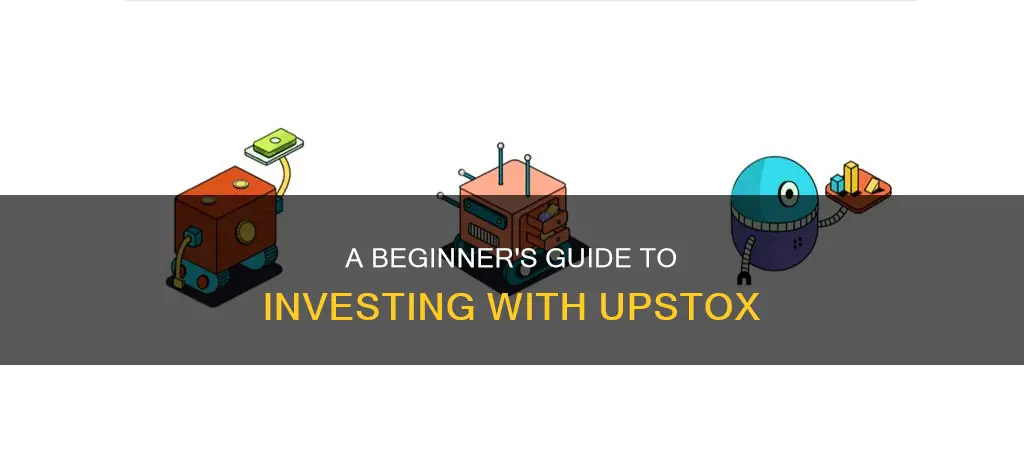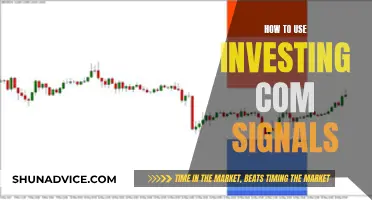
Upstox is an online platform that simplifies stock investing for beginners. It offers a range of investment options, including stocks, mutual funds, and IPOs, with zero commission on mutual funds. To get started, users can open a free Demat and Trading account. Upstox provides resources to help users navigate the process of investing, from setting goals and choosing industries to selecting specific stocks and indices. The platform also allows users to link their bank accounts and offers a mobile app for on-the-go trading. With its user-friendly interface and educational content, Upstox empowers new investors to make informed decisions and build a diverse portfolio.
| Characteristics | Values |
|---|---|
| Account opening requirements | Choose the right broker to help you understand your account opening process |
| The choice of brokerage would depend on factors such as fees/charges, client benefit, additional offices and platform's interface and experience | |
| Dematerialized account opening techniques | Conventional format (paper form) |
| E-KYC paperless registration (online) | |
| Trading terms | IPO, portfolio, yield, index, sector, P/E ratio |
| Settlement period | Duration it takes for all the trades on a particular day to be allotted/reconciled to demat accounts (usually T+2 days) |
| Upstox investors mode | Designed for investors new to stock investing |
| Orders that can be placed on investors mode | CNC (Delivery order) at a market price or custom (limit) price |
| Intraday order | Cannot be placed on Upstox investors mode |
| Market price | The price of the security at which it is currently trading |
| Custom price | The price of the security that the user selects for investment |
| Sell a share | Cannot be sold before buying it |
| Exchange for order execution | NSE or BSE |
| Trading in NSE and BSE | Can be switched on the Stock details page |
What You'll Learn

How to open a Demat and Trading account with Upstox
To open a Demat and Trading account with Upstox, you can follow these steps:
Online Method:
- Visit the Upstox website or download the Upstox app.
- Sign up with your mobile number and verify it with the OTP sent to that number.
- Set a 6-digit PIN to sign in.
- Log in with the 6-digit PIN.
- Add your email address.
- Verify your email with the OTP sent to the registered email ID.
- Enter your personal details and click 'Continue'.
- Draw or upload your signature, ensuring it matches your PAN.
- Enter your PAN details and date of birth.
- Verify your KYC and bank details.
- Link your savings/current bank account for fund transfers.
- Select the brokerage plan benefits you want.
- Add nominees for your account.
- Verify your application with your Aadhar and the OTP sent to your Aadhar-linked mobile number.
Traditional Offline Method:
- Visit your broker's office or meet with one of its employees.
- Fill out the account opening form and attach proof of identity and address.
- Sign an agreement with your broker outlining the responsibilities of both parties.
- Your broker will verify and process your documents.
- You will be assigned a Beneficial Owner account number.
Documents Required:
- PAN card.
- Aadhaar card.
- Scanned copies of your bank statement, cancelled cheques, and PAN card.
- Passport-size photos.
Charges:
Upstox offers a Demat Account with zero annual maintenance charges. There are no account opening or maintenance fees, and you only pay a small brokerage amount when placing an order.
Points to Remember:
- Link your Demat account to your trading account.
- Be aware of all the Demat account fees and charges.
- Ensure your information is accurate before submitting any forms.
- Set up a nominee for your account to simplify future share transfers.
By following these steps, you can open a Demat and Trading account with Upstox and start investing.
Investing Before Elections: Cash or Risk?
You may want to see also

How to choose stocks and industries
Choosing stocks and industries can be an intimidating process, especially for beginners. There are 11 different stock market sectors, 69 distinct industries, more than 8,000 securities and about 4,000 listed companies across the major U.S. exchanges. Here are some guidelines to help you choose:
Understand your goals, timeframe and risk tolerance:
Before picking stocks, it's important to outline your goals, timeframe and risk tolerance. For example, if you're a young investor looking to build a multimillion-dollar stock portfolio by the time you're 40, you'll likely focus on high-risk, high-reward growth stocks. On the other hand, if you have a shorter investment horizon and want to play it safe, you might consider blue-chip companies and dividend stocks.
Do your research:
Once you know what you're looking for, it's time to research specific stocks. There are two primary strategies: fundamental analysis and technical analysis. Fundamental analysis evaluates a stock based on the company's financial health and performance, including metrics such as earnings growth, profitability and revenue growth. Technical analysis, on the other hand, focuses on historical trading data, such as price and volume, to predict future price movements.
Diversify your portfolio:
Diversification is key to managing risk. Owning stocks from a variety of sectors can add stability to your portfolio. According to financial advisors, investors should own at least 5 to 10 different stocks, and no single stock should make up more than 10% to 20% of your portfolio.
Understand financial ratios:
When analysing stocks, investors often look at financial ratios such as the working capital ratio, quick ratio, earnings per share (EPS), price-to-earnings (P/E), debt-to-equity ratio, and return on equity (ROE). Comparing these ratios across different companies and industries can help you make more informed investment decisions.
Avoid value traps:
Be cautious of 'value stocks', which may appear undervalued compared to their peers. Sometimes, a company's stock price can be low due to poor performance or a lack of future growth prospects. Consider qualitative factors like management effectiveness, competitive advantage, and potential catalysts to avoid value traps.
Choose stocks with a competitive advantage:
Look for companies with a sustainable competitive advantage, also known as a 'moat'. This could be in the form of economies of scale, brand recognition, patents or cost leadership. A strong competitive advantage can lead to higher margins and consistent cash flow, increasing the company's value over time.
Fantasy Football Cash: Strategies for Smart Investments
You may want to see also

How to buy stocks using Upstox
Upstox is a leading fintech platform in India with a user-friendly interface and a range of features for seamless stock trading. Here is a step-by-step guide on how to buy stocks using Upstox:
Step 1: Explore the Upstox Website
If Upstox suits your financial goals, proceed to open an account by clicking the "Open Account" button.
Step 2: Choose Your Account Type
Select the account type that aligns with your trading requirements. Options include a FREE Demat account and a Trading account. You can also invest in Mutual Funds and IPOs with zero commission.
Step 3: Complete the Account Opening Process
Fill in the required details, such as your name, address, contact information, PAN card number, and bank details. Upload the necessary documents and ensure that the information provided is accurate and up to date.
Step 4: Complete the Paperless e-KYC Process
This step involves verifying your identity and address.
Step 5: Verify Your Account
After completing the account opening process, you will receive an email or SMS notification about your account verification status.
Step 6: Explore the Upstox Trading Platforms
You can use the Upstox website or mobile app to buy shares online. Familiarize yourself with the platform and the various trading segments.
Step 7: Conduct Independent Research and Analysis
Use the Upstox research tools to your advantage. Glance at company financials, track market trends, and access stock updates to make informed investment decisions.
Step 8: Buy Shares
- Log in to the Upstox website or mobile app.
- Transfer funds from your bank to your trading account.
- Search for the desired company in your watchlist.
- Enter order details such as quantity, order type, position, and validity.
- Review and confirm the order.
After placing your order, the shares will be credited to your Demat account after T+2 days, where T is the day of trading.
Additional Tips:
- Remember to regularly monitor the performance of your investments and manage your portfolio according to your investment preferences. Upstox provides real-time market data to help you stay informed.
- A Demat account is essential for trading or investing in the Indian financial market. It is a digital account that stores your shares purchased through a stock exchange.
- You must also have a trading account connected to your bank account to facilitate investing. Brokers provide both Demat and trading accounts.
Strategies to Invest Cash Without Involving the IRS
You may want to see also

How to sell stocks using Upstox
To sell stocks using Upstox, you need to have a Demat account, which is essential for trading or investing in the Indian financial market. A Demat account is a digital account used to store the shares you purchase through a stock exchange like the NSE or BSE.
For NON-POA Customers:
- Log in to the Upstox trading platform.
- Go to 'Portfolio' and click on 'Holdings'.
- Select the stock you want to sell and click on 'Sell'.
- Choose the exchange on which you want to sell your shares.
- Fill in the details on the order entry page and click on 'Review sell order'.
- After reviewing, click on 'Submit Order'.
- If you have a TPIN, click on 'Continue to CDSL'. If you don't have a PIN, click on 'Generate New PIN'. You will receive it on your registered email and mobile number.
- Enter your TPIN and click on 'Verify'.
- Enter the OTP sent to your registered mobile number and email for verification.
- Confirm your order on the order confirmation page.
For POA Customers:
To sell shares without a physical POA, you can use the e-DIS (electronic-delivery instruction slip) facility. Here are the steps:
- Click on 'Sell'.
- Authorise the sale by entering the OTP sent to your registered phone number and email.
- Enter the OTP to proceed with selling your shares.
Please note that the daily selling limit for your holdings is Rs. 75 lakhs, as advised by CDSL. Also, remember that you can buy shares on one exchange and sell them on another the next day (T+1 day) but not the same day.
Extra Cash? Here's How to Invest Wisely
You may want to see also

How to switch between trading in NSE and BSE
Upstox has created a separate mode for investors, who are new to the world of stock investing. This mode simplifies the process of investing.
To switch between trading in the National Stock Exchange (NSE) and the Bombay Stock Exchange (BSE), follow these steps:
- Go to the Stock Details page.
- Click on the switcher button to switch between NSE and BSE.
You can buy shares on one exchange and sell the same number of shares on another exchange the next day (T+1 day). For example, if you buy 10 shares of TCS on Monday on the NSE, you can sell those 10 shares on the BSE on Tuesday.
However, if you buy a stock for intraday trading on the NSE, you cannot square off the long position on the BSE, or vice versa. If you do so, two separate intraday positions will be created. To square off your intraday positions, you must exit your intraday position on the same exchange.
Some stocks may only be listed on either NSE or BSE, so be sure to check the availability of the stock on the selected exchange.
Understanding Owner Cash Investments: Reporting and Strategies
You may want to see also
Frequently asked questions
You can open a FREE* Demat + Trading account with Upstox. You can use the e-KYC method, where the broker verifies your information using your Aadhaar card, and you upload your documents online.
Upstox has a simplified and intuitive buying and selling experience. It also has a separate mode for investors, where you can track all your wealth in one app, import external Mutual Funds, and link Bank Accounts.
On Upstox, you can place a CNC (Delivery order) at a market price or custom (limit) price. You can also place a Buy order which you can sell on the same day.
First, get used to the trading platform you will be using. Then, link your bank account to your trading account. You can then start buying stocks from the market using the money in your trading account.







